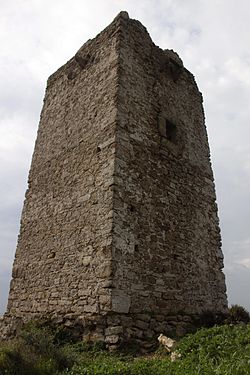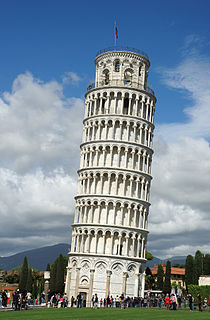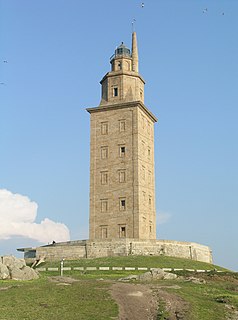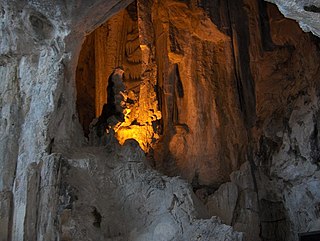| Friar Tower | |
|---|---|
| Native name Spanish: Torre del Fraile | |
the remains of the Torre del Fraile | |
| Location | Algeciras, Spain |
| Coordinates | 36°03′27″N5°27′10″W / 36.05746°N 5.45265°W Coordinates: 36°03′27″N5°27′10″W / 36.05746°N 5.45265°W |
| Built | 1588 |
| Architect | Luis Bravo de Acuña and Juan Pedro Laguna |
| Official name: Torre del Fraile | |
| Type | Non-movable |
| Criteria | Monument |
The Torre del Fraile (Tower Canutos or Friar Tower) is one of a set of military watchtowers built around the South and East coast of Spain to keep an eye on passing shipping and Barbary pirates. The watchtowers were in sight of one another and it was therefore possible to get a signal to Gibraltar from the watchtower in Tarifa. The tower was designed by Luis Bravo and Juan Pedro Laguna in 1588.

Spain, officially the Kingdom of Spain, is a country mostly located on the Iberian Peninsula in Europe. Its territory also includes two archipelagoes: the Canary Islands off the coast of Africa, and the Balearic Islands in the Mediterranean Sea. The African enclaves of Ceuta and Melilla make Spain the only European country to have a physical border with an African country (Morocco). Several small islands and a peninsula bordering Morocco in the Alboran Sea are also part of Spanish territory. The country's mainland is bordered to the south and east by the Mediterranean Sea except for a small land boundary with British dependency Gibraltar; to the north and northeast by France, Andorra, and the Bay of Biscay; and to the west and northwest by Portugal and the Atlantic Ocean.

The Barbary pirates, sometimes called Barbary corsairs or Ottoman corsairs, were Ottoman and Maghrebi pirates and privateers who operated from North Africa, based primarily in the ports of Salé, Rabat, Algiers, Tunis, and Tripoli. This area was known in Europe as the Barbary Coast, a term derived from the name of its ethnically Berber inhabitants. Their predation extended throughout the Mediterranean, south along West Africa's Atlantic seaboard and into the North Atlantic as far north as Iceland, but they primarily operated in the western Mediterranean. In addition to seizing merchant ships, they engaged in Razzias, raids on European coastal towns and villages, mainly in Italy, France, Spain, and Portugal, but also in the British Isles, the Netherlands, and as far away as Iceland. The main purpose of their attacks was to capture Christian slaves for the Ottoman slave trade as well as the general Arab slavery market in North Africa and the Middle East.

Gibraltar is a British Overseas Territory located at the southern tip of the Iberian Peninsula. It has an area of 6.7 km2 (2.6 sq mi) and is bordered to the north by Spain. The landscape is dominated by the Rock of Gibraltar at the foot of which is a densely populated town area, home to over 30,000 people, primarily Gibraltarians. It shares a maritime border with Morocco.
The tower is about 240 metres back from the sea and Cala Arenas and 120 metres above it. [1] The tower is over six metres in diameter and was over thirteen metres high until the top collapsed in 2006 with the loss of a window and the upper staircase. The tower's entrance was over five metres in the air and this led onto a floor. From this the soldiers could climb to the top where space was reserved for firewood for signalling.

Cala Arenas is a beach situated near the city of Algeciras in Spain, within the El Estrecho Natural Park. It is located at the southern end of the Bay of Gibraltar and faces the Strait of Gibraltar. It measures about 400 metres (1,300 ft) long by about 30 metres (98 ft) deep. The beach is somewhat difficult to access, but can be reached via coastal paths from Punta Carnero and Punta del Fraile. It consists of a series of three small coves of similar appearance, with beaches of rocks and small stones. Both the terrestrial and marine environment of the area lies within the natural park. Its surroundings are largely undisturbed by human activity; the nearest settlement is the coastal community of Getares, a small outlying development of the city of Algeciras located about 1 km to the north. The beach is framed by cliffs and the Isla de las Palomas lies a short distance offshore.


















